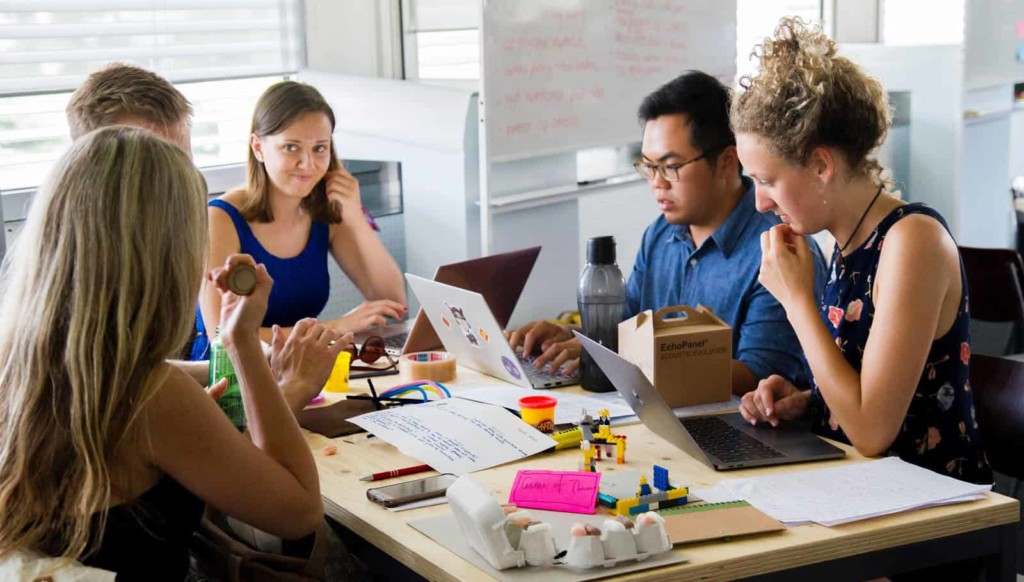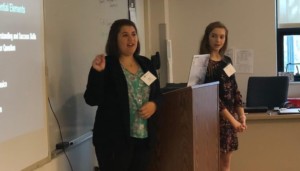How Are We Training Today’s Students for the Growing Gig Economy of Tomorrow

According to Nasdaq, 34% of the American workforce is a part of the “Gig Economy,” where self-employment and freelancing have replaced cubicles and commuting. This number is expected to grow to 43% by 2020 (Business Insider, 2017.) As educators, we hear often that we are preparing students for jobs that do not actually exist yet. This revelation requires us to shift our paradigm of all educational practices from curriculum, instruction, assessment and beyond. Most profoundly it forces us to help students learn habits, mindsets and approaches to projects that will prepare them for a dynamic and constantly evolving workforce.
At Columbus Signature Academy New Tech High School, we love the fact that our day-to-day instruction spans far beyond content. As with all New Tech Network schools, you could say that it is in our DNA to be thinking always about the transferable skills, not just content, that our kids take with them to college and beyond. After having spent the last ten years trying to adapt to the changing economy, here are lessons learned during our Project- Based Learning journey that we feel prepare students for the Gig Economy and a changing world in general.
1. Intentional and direct teaching of interpersonal communication skills. New Tech Network has developed a clear set of targets for students around oral and written communication and we focus on the development of these skills explicitly. And while formal presentations are certainly a major component of what we have students practice, the focus really is on a variety of speaking and writing tasks. We practice professional phone calls, emails, social media posts, prototype presentations feedback sessions, thank you notes, elevator speeches and any other conceivably realistic communication skill. These clear, detailed and accessible rubrics and checklists are available for all to use and I would encourage any curious teacher to take a look.
As a result of the instruction on these skills and assessment using these high-quality tools, our students excel at talking about their ideas and demonstrating a passion for them. A couple of years ago, we developed ideas for a community-wide riverfront development project. Students presented their ideas to a virtual all-star panel of community leaders, including the mayor. While none of these students became experts in urban design, they developed a contagious enthusiasm for their ideas and were happy to talk about them. We were surprised to receive an award from Mayor Lienhoop at an annual banquet and in his remarks, he spoke to the students’ ability to speak about their ideas. Those same students, now juniors, recently pitched startup ideas in a “Shark Tank”- style presentation to local business leaders. Needless to say, they are getting a lot of great practice communicating their ideas about how they would like to change the world. I’m thinking they are going to.
2. Growth Mindset. This philosophy, pioneered by Carol Dweck, has the capacity to change a lot of traditional education practice. From embracing failure and setbacks to embracing critical feedback, Dweck’s mantras, when put to use in the classroom, offer a great many lessons that apply directly to the “gig” freelancer and beyond. Encouraging students to embrace the struggle and praising their effort instead of their intelligence sends the message that the new economy needs people that are willing to put in the hard work and not give up easily.
Like most teachers, my co-facilitator and I do homework checks. When we do, it is often with the goal of seeing which students demonstrate what we refer to as “evidence of effort.” This may look very different, obviously, for the task or for the student. For some students, that effort is clear and present from day one, and for others, it might not be there “yet.” Dweck’s emphasis on the “not yet” framework of feedback and assessment has fundamentally changed how we do school, and it translates with ease to the need for prototyping, failure, and revision in the work world.
3. Encourage pursuit of personal passion. We have found that there is absolutely a middle ground between rigid curriculum and free-form “learn what you want” approaches. There will always be standards students must learn and there will always be a test to prepare for, just like there will always be certain demands placed by a client or boss. We create frequent opportunities for students to have outlets for their own approaches to applying the content. If great ideas come from thinking “outside the box,” it is also true that being given a “box” (solution constraints) is both realistic as well as potentially cathartic.
While somewhat new to the Genius Hour game, our students have responded very positively to its implementation in a PBL environment. There is virtually no limit to the topics that our students are allowed to explore, so long as they do their due diligence with research on their topic and produce a research paper. Beyond that, they may apply their passions in almost any way they wish.
Campbell Thomasson is a Freshman at the University of Indianapolis and in addition to succeeding in the classroom, he is taking on leadership roles on campus and has started his own DJ business. Reflecting on high school, he says, “The PBL environment I experienced helped me prepare and equip myself with the skills and ingenuity of a 21st Century entrepreneur. The collaborative and project-based culture helped me build the required skills and mindset of a strong problem solver. With my discovered talents I was able to create my own DJ business, which provided me the opportunity to grow my skills in a fun and creative manner and learn interdependently with peers and clients.”
4. Human-Centered Design. This approach works really beautifully with PBL. It starts with a client, who has needs (and again, constraints.) Said client presents their request to students, who must learn content in order to meet that customer’s needs. A prototype is presented to the client or focus group, and after some experience with the prototype, feedback goes back to the students and another iteration is created. This process repeats until the client is pleased with the end product.
We have used Human-Centered Design many times to give students a feel for what it means to work directly with clients and customers in the development of a product. From the creation of a “Lego Lab” for elementary students, a “Tree of Life” exhibit for KidsCommons (our local children’s museum) to the redesign of outdoor space for a local community center, our students have experiences that help them better experience the designer-client experience.
5. Recognizing students’ demonstration of the Habits of Mind. In particular the habits of persisting, metacognition (thinking about thinking,) and thinking flexibly seem like apt qualities for members of the Gig Economy to possess. Successes will be preceded by failures and as such, students must embrace persistence. If one is to be their own boss, they had better have a good understanding of how they tick, so they recognize when it’s time to get help or seize an opportunity. It goes without saying that everything about the world today demands flexible thinking and adaptability, especially if one’s next meal depends on it!
These Habits of Mind are the foundation of our Positive Behavior Interventions & Support (PBIS) system at school. When a student is observed demonstrating one of the Habits of Mind, he or she may be handed a Habit Gram, which gets entered into a weekly raffle for prizes. It’s just one more way that we try to recognize the behaviors that not just us, but the world, is seeking in the future workers of the world.
Hitting a moving target is never easy, but when it comes to employable (and self-employable) skills, the strategies described here are the ones I invite other educators to consider. We see and hear from our graduates that they are benefiting from having practiced these skills often and learned them early. After all, there is no such thing as being too ready for anything.
Mikala Lomax, now a graphic design major in college and also a gifted photographer, has made a big impression on her hometown with her print and t-shirt business. She reflects that “While attending CSA, I was already accustomed to seeing “failures” as learning opportunities rather than something to be feared. Especially in a PBL environment where I was constantly challenged with different hands-on projects, just as I am today being self-employed. Not every client will like every iteration of a design that I do. Not every process is successful 100% of the time. But through persistence and flexibility, I’m constantly learning new things and improving every day.”
For more, see:
- Training Today’s Learners to be the Hired Guns of Tomorrow
- Getting Students Ready for the Gig Economy
- What We are Doing to Ensure High Quality PBL for All
Stay in-the-know with all things EdTech and innovations in learning by signing up to receive the weekly Smart Update. This post includes mentions of a Getting Smart partner. For a full list of partners, affiliate organizations and all other disclosures, please see our Partner page.





0 Comments
Leave a Comment
Your email address will not be published. All fields are required.